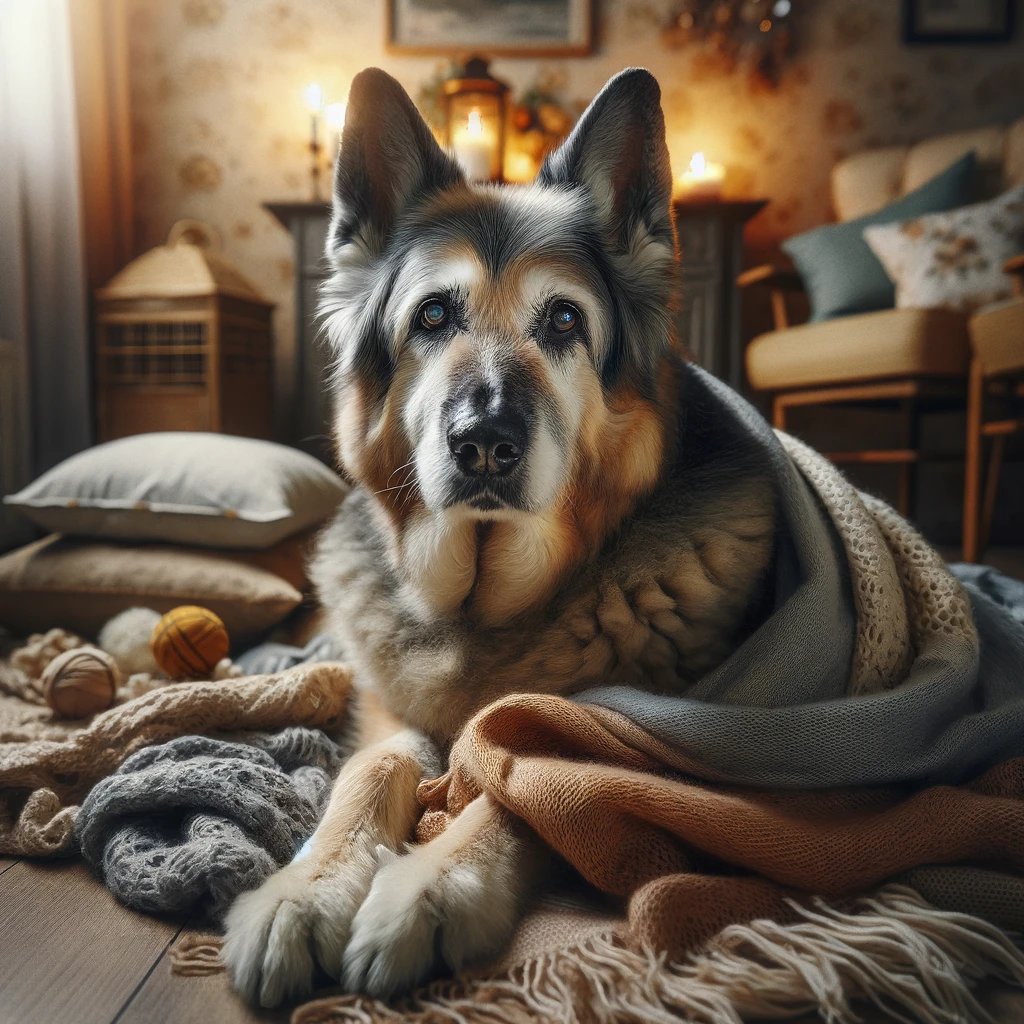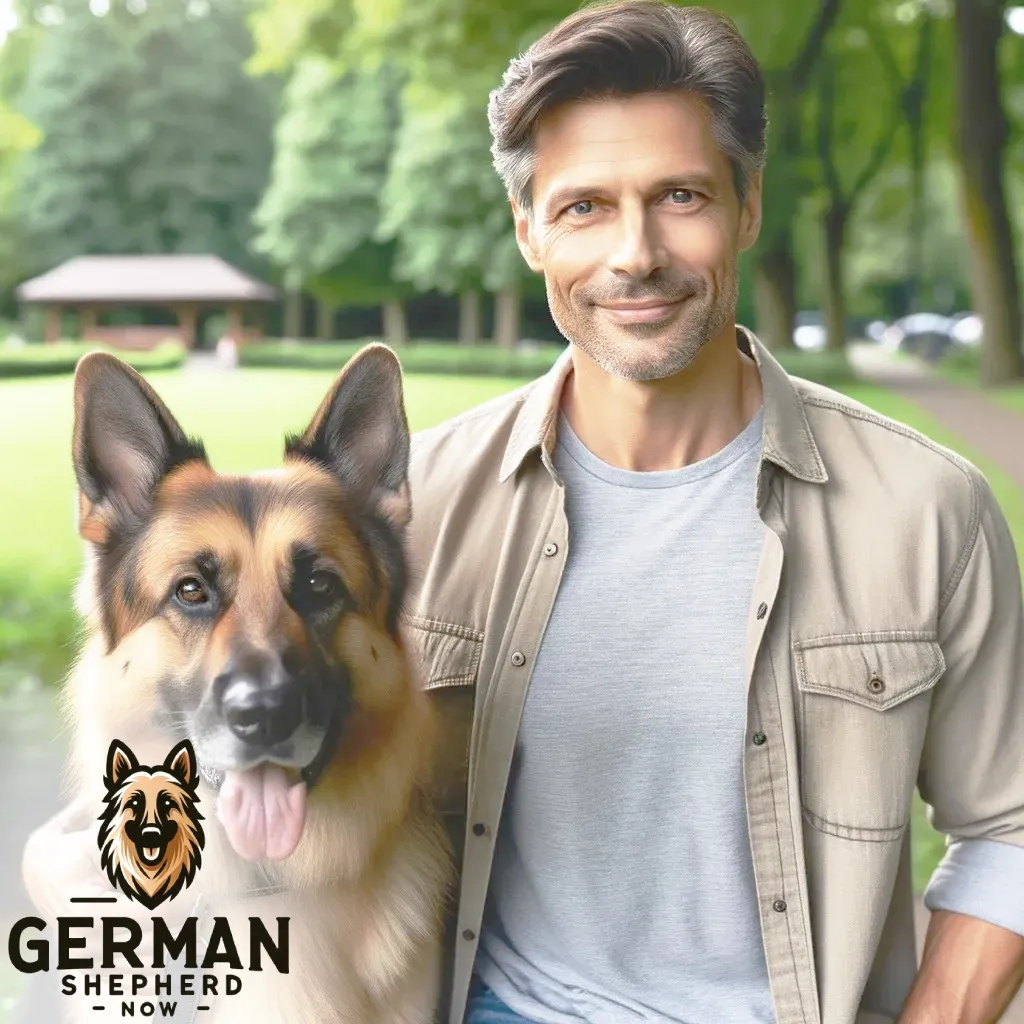German Shepherd End-of-Life Symptoms

As German Shepherds near the end of life, common symptoms include decreased activity levels, loss of appetite, breathing difficulties, and having accidents inside the home.
Owners may also notice their German Shepherd isolating themselves, experiencing confusion or anxiety, or crying out in pain or distress.
With their lifespan being around 9-13 years on average, German Shepherds unfortunately can develop age-related health conditions like arthritis, cancer, or organ failure in older age.
Recognizing and managing end-of-life symptoms lets owners keep their German Shepherds comfortable during their final days.
End-of-Life Symptoms in German Shepherds
Recognizing the end-of-life symptoms in German Shepherds is crucial for providing them with the care and compassion they deserve in their final days.
Here are signs that indicate a German Shepherd may be nearing the end of its life. Each sign warrants attention and understanding to ensure the best possible care for your aging companion.
Decreased Mobility
As German Shepherds approach the end of their lives, a noticeable decrease in mobility is common. They may struggle to stand up, climb stairs, or resist moving around. This reduced mobility can be due to joint pain, arthritis, or general weakness.
It’s essential to provide them with a comfortable resting area and avoid forcing them to move more than necessary.
Adjusting their living space to make it more accessible and comfortable can improve their quality of life.
Significant Loss of Appetite
A marked decrease in appetite is a prominent sign. An older German Shepherd may start eating less or refuse food altogether. This change can lead to weight loss and a general decline in health.
While a decreased appetite can be part of normal aging, it can also indicate illness or discomfort.
Offering palatable, easy-to-eat food can sometimes help, but it’s important to consult a vet for advice, especially if the loss of appetite is sudden or severe.
Increased Lethargy
Increased lethargy or constant fatigue is a significant indicator. You may notice your German Shepherd sleeping more than usual or showing no interest in activities they once enjoyed.
This lethargy can be due to decreased energy levels, pain, or other underlying health issues. It’s important to respect their need for rest while ensuring they are comfortable and their basic needs are met.
Changes in Behavior
Behavioral changes are common in German Shepherds nearing the end of life. They may become more irritable, disoriented, or withdrawn. Some dogs may seek more affection, while others prefer to be alone.
Recognizing and respecting these changes in behavior is vital, ensuring they feel safe and loved without causing additional stress.
Labored Breathing
Difficulty breathing or labored breathing can be a distressing symptom. This may manifest as shortness of breath, rapid breathing, or a persistent cough.
These respiratory changes can be due to heart or lung problems and should be evaluated by a vet to provide appropriate care and make your dog as comfortable as possible.
Loss of Bladder and Bowel Control
German Shepherds may lose control over their bladder and bowels as they age. This loss of control can be due to a decline in their physical strength or neurological issues.
Providing an easy-to-clean and comfortable living area and frequent opportunities for bathroom breaks can help manage this symptom.
Visible Pain or Discomfort
Signs of pain or discomfort, such as whimpering, restlessness, or reluctance to be touched in certain areas, are crucial indicators. Pain management becomes a priority at this stage. Your vet can suggest medications or therapies to alleviate pain and improve comfort.
Changes in Drinking Habits
Altered drinking habits, either too much or too little, can signify that a German Shepherd is nearing the end of life.
Dehydration or excessive drinking can be a response to underlying health issues. It is important to monitor their water intake and consult with a vet for any drastic changes.
Physical Deterioration
Physical deterioration can be observed, such as muscle wasting, poor coat condition, or unexplained lumps or bumps. This deterioration is a natural part of aging but can also indicate more severe health problems.
Regular check-ups with the vet are essential to address any concerning physical changes.
Seizures or Convulsions
In some cases, older German Shepherds may experience seizures or convulsions. These can be caused by brain tumors, organ failure, or other neurological conditions.
Immediate veterinary attention is crucial to manage this symptom and determine the underlying cause.
The End of Life Process in German Shepherds: A Timeline
The end-of-life process for a German Shepherd can vary in terms of duration and symptoms experienced.
While it’s challenging to pinpoint a specific timeline due to individual health and environmental factors, understanding the general stages can help owners prepare and provide compassionate care.
Here’s an approximate timeline based on common patterns observed in aging German Shepherds:
Initial Stage: Gradual Onset (Months to a Year)
- Early Signs: Signs are subtle and may include reduced energy levels, slight changes in mobility, and minor shifts in behavior or appetite. This phase can last several months to a year progressing.
- Owner Action: Regular veterinary check-ups are crucial. Adjustments to diet, exercise, and living arrangements can maintain quality of life.
Middle Stage: Increased Symptoms (Weeks to Months)
- Progressing Symptoms: Symptoms become more pronounced. Mobility issues may worsen, leading to difficulty in standing or walking. Appetite decreases noticeably, and weight loss may occur. Behavioral changes like increased irritability or withdrawal are common.
- Owner Action: Consult a veterinarian for pain management strategies and possible dietary adjustments. Comfort measures, like orthopedic bedding and accessible food/water dishes, have become more important.
Advanced Stage: Marked Decline (Days to Weeks)
- Intensified Symptoms: In this phase, symptoms are severe. The dog may experience significant pain, pronounced difficulty in moving, refusal to eat, and possible incontinence. Breathing difficulties, severe lethargy, and disorientation are common.
- Owner Action: Veterinary guidance is vital. The focus is on palliative care to ease discomfort. Decisions about the dog’s quality of life and possible euthanasia may be considered.
Final Days: End of Life (Hours to Days)
- End-of-Life Signs: The dog may show a complete loss of appetite, extreme weakness, unresponsiveness, labored breathing, and possible seizures. At this point, they often cannot move and show little to no interest in their surroundings.
- Owner Action: Ensuring the dog’s comfort is paramount. This is a time for goodbyes, and if chosen, arrangements for euthanasia are made to allow the dog to pass without suffering.
Helping Your German Shepherd Through the End-of-Life Process
Helping a German Shepherd through its end-of-life process is a compassionate journey that involves understanding, care, and often difficult decisions.
It’s about making your beloved pet’s final days as comfortable and peaceful as possible. Here’s a guide to navigating this challenging time.
Providing Comfort
Focus on creating a comfortable environment for your German Shepherd. Provide soft bedding to ease joint pain, ensure easy access to food and water, and maintain a calm, quiet space.
Adjust their position to prevent bedsores and speak to them soothingly to provide emotional support.
Managing Pain
Work closely with your veterinarian to manage your dog’s pain effectively. They may prescribe medications for pain relief or suggest supplements to ease joint discomfort.
Monitoring your dog’s reactions to medications and making necessary adjustments is key to ensuring their comfort.
Nutritional Support
As their appetite wanes offer small, frequent meals of palatable, easy-to-digest food. Warm the food to enhance its smell and appeal.
Consult your vet for dietary supplements or hydration advice if your dog struggles to eat or drink.
Emotional Support
Continue to show love and affection to your German Shepherd. Gentle petting, brushing, or sitting with them can be comforting.
Be responsive to their needs for interaction or solitude, as their preference for social contact may vary during this time.
Veterinary Care
Regular veterinary check-ups are essential. Your vet can monitor your dog’s condition, adjust pain management, and provide guidance on care. They can also help you recognize signs of suffering and advise on quality-of-life considerations.
Making Difficult Decisions
Be prepared to make tough decisions regarding euthanasia when your dog’s quality of life declines.
Discuss with your vet when it might be the most humane option. It’s a personal decision made out of love and compassion for your pet’s well-being.
Final Goodbyes
Allow yourself and your family to say goodbye in the right way. This can be a quiet moment with your dog, sharing memories, or a simple, loving farewell. These moments can be crucial for emotional closure.
Aftercare Arrangements
Decide on aftercare in advance, whether it’s burial or cremation. Knowing your options and having a plan can ease stress during grief.
Grieving Process
Allow yourself to grieve. Losing a pet is losing a family member, and it’s important to acknowledge and express your feelings. Seek support from friends, family, or pet loss support groups if needed.
Honoring Memories
Create a tribute or memorial to honor the life and memories of your German Shepherd. This could be a photo album, a planted tree, or a special place in your home. It’s a way to remember and celebrate the bond you shared.
Preserving Memories of Your German Shepherd
To hold onto the cherished memories of your German Shepherd, consider creating a special photo album that captures moments from their puppyhood through to their senior years, telling the story of your shared journey.
Another heartfelt keepsake is a paw print made with clay or ink, which can be framed or displayed in your home as a tangible reminder of your companion.
You could also commission a portrait of your German Shepherd, having an artist capture their likeness in a beautiful piece of art.
Consider keeping a small lock of your dog’s fur in a locket or a small keepsake box for a personal memento. This way, you’ll always have a part of your beloved pet with you, preserving the bond you shared in various meaningful and lasting ways.
The Final Chapter: German Shepherd’s End-of-Life
In the journey of pet ownership, understanding and acknowledging the end-of-life symptoms in a German Shepherd is a vital part of providing them with the love and care they deserve during their final days.
As they approach this stage, German Shepherds exhibit decreased activity levels, loss of appetite, breathing difficulties, and accidents inside the home.
Behavioral changes like isolation, confusion, anxiety, or vocalizing pain or distress are also indicators of their declining health.
Given their average lifespan of 9-13 years, it’s not uncommon for them to develop age-related conditions like arthritis, cancer, or organ failure.
Recognizing these symptoms is essential in managing their comfort and ensuring they are at ease in their last moments.
It’s a time for owners to provide compassionate care, making their German Shepherd’s final days as comfortable as possible and cherishing the time left with their loyal companion.

I’m Martin, and I grew up in the super cool city of Seattle. You know, the place with all the incredible mountains and forests? Yeah, that’s my playground!
Ever since I was little, I’ve been all about nature. I used to wander around the woods with a notebook, doodling all the cool plants and animals I’d find.
